Abstract
The Japan Proton Accelerator Research Complex (J-PARC) is a hadron-accelerator facility that aims to provide secondary beams of kaons, pions, neutrinos, muons, and others together with the primary proton beam for investigating a wide range of science projects. High-energy hadron physics can be studied by using high-momentum beams of unseparated hadrons, which are essentially pions, and also primary protons. In this report, possible experiments are explained on color transparency and generalized parton distributions (GPDs). These projects are complementary to lepton-scattering experiments at Jefferson Laboratory (JLab), COMPASS/AMBER, and future electron-ion colliders. Thank to hadron-beam energies up to 30 GeV, J-PARC is a unique facility to investigate the transition region from the hadron degrees of freedom to the quark-gluon degrees of freedom. It is suitable for finding mechanisms of the olor transparency. Such color-transparency studies are also valuable for clarifying the factorization of hadron production processes in extracting the GPDs from actual measurements. These studies will lead to the understanding of basic high-energy hadron interactions in nuclear medium and to clarifications on the origins of hadron spins, masses, and internal pressure mechanisms.
1. Introduction
The Japan Proton Accelerator Research Complex (J-PARC) is a multi-purpose facility ranging from life sciences to nuclear and particle physics [1,2]. By using secondary beams of kaons, pions, neutrinos, muons, and others as well as the primary proton beam, a wide range of experiments are possible. The list includes an experiment on neutrino oscillations, projects, including those to probe physics beyond the standard model by lepton-flavor violation, on muon g factor , rare kaon decays, the neutron electric-dipole moment. The J-PARC is a flagship facility not only in particle physics but also in hadron physics.
The J-PARC hadron physics, so far, focuses on low-energy hadron and nuclear physics with strangeness. It is a unique project in extending our knowledge of standard nuclear physics by exploring the new flavor degrees of freedom, strangeness. The recent highlights are discoveries on: (1) event excess observed by the missing spectrum of toward understanding kaonic- and hyper-nuclei, (2) the -bound state in , and (3) the –-bound system with an binding energy of 1.27 ± 0.21 MeV and subsequent findings on other bound states [3,4,5,6]. Such strangeness nuclear physics studies will be continued at J-PARC, and our knowledge of the current nuclear physics will be expanded to new realms. These investigations will lead to the understanding of the equation of state for neutron-star matter, which is a developing field with recent progress in astrophysical observations, including gravitational waves. Right now, the hadron-hall extension is under consideration, and charmed hadron physics will be also an interesting topic at J-PARC.
In addition, high-momentum beamlines with primary 30-GeV protons and unseparated hadrons, mainly pions, are now available up to about 20-GeV/c momentum; here c is the speed of light. These hadron beam energies are not very high, which indicates a unique opportunity to investigate the intermediate region from hadron degrees of freedom (d.o.f.) to the quark and gluon d.o.f. described by perturbative quantum chromodynamics (QCD). In this sense, J-PARC is a similar facility to the Thomas Jefferson National Accelerator Facility (JLab); however, it is complementary to JLab projects because different aspects can be investigated by hadron reactions.
Such complementarity is clear in the studies of the color transparency and the generalized parton distributions (GPDs). The color transparency means that a hadron is expected to pass freely through the nuclear medium during large momentum transfer. There was a mysterious experimental result from the BNL-AVA Collaboration in 2004 in which the transparency increased with the beam momentum as expected; however, it started to drop at about 10 GeV [7]. This was inconsistent with the color transparency prediction, which cannot be explained at this stage. Since the BNL-AVA measurement is not understood easily, it should be confirmed by independent experiments, and J-PARC is the ideal facility for this experiment. There was a new color-transparency measurement from the JLab where the transparency does not appear even up to momentum transfer squared 14 GeV in 2021 [8]. Together with this new development, a possible J-PARC experiment becomes more valuable for finding the mechanism. It is a timely project, considering the new experimental development at JLab in connection with the peculiar BNL-AVA result and because the high-momentum beam line is now ready at J-PARC.
On the other hand, the GPDs can be investigated in the same processes at hadron accelerator facilities [9,10,11]. In particular, the color transparency argument is essential for factorization of the processes in extracting the GPDs from experimental measurements [12]. The GPDs are valuable quantities for understanding the origins of hadron mass and spin compositions; for reviews, see [13,14,15,16] (see also [9,17,18]). The GPDs contain information on form factors and parton distribution functions (PDFs), and their second moments are related to quark orbital-angular-momentum contributions to the nucleon spin. Furthermore, they are related to gravitational form factors of hadrons as shown; for example, in Ref. [17], they are also important for finding mechanisms of hadron mass and internal pressure generations. Therefore, the GPDs will play a crucial role in future developments of hadron physics. It is believed that their studies will lead to understanding on the origins of nucleon spin and mass in terms of quarks and gluons. In this report, possible high-energy hadron-structure physics, especially that related to color transparency, is discussed along with possible projects on the GPDs.
2. Transition from Hadron to Quark-Gluon Degrees of Freedom and Color Transparency
2.1. Hard Exclusive Reactions and Constituent Counting Rule
Let us consider a high-energy exclusive reaction. The cross-section for a hard exclusive hadron reaction is generally expressed by the partonic scattering term and lightcone amplitudes, , and its matrix element is given by [18,19,20]
Here, is a set of the lightcone momentum fractions for the parton i and the hadron h. The matrix element or the cross-section is described by the hard part calculated in perturbative QCD and the soft one given by the distribution amplitudes. A typical hard exclusive process is shown in Figure 1. The exclusive reaction is possible if the hard momentum is shared among the constituents, which should be close to each other (“small hadron hadron component”) to form a hadron in the final state. Assigning the hard gluon and quark propagators as well as external quark factors, one obtains the cross-section expressed by the Mandelstam variables s and t as [18,19,20,21,22]
where is a function which depends on the scattering angle, and n is the total number of constituents () involved in the reaction.
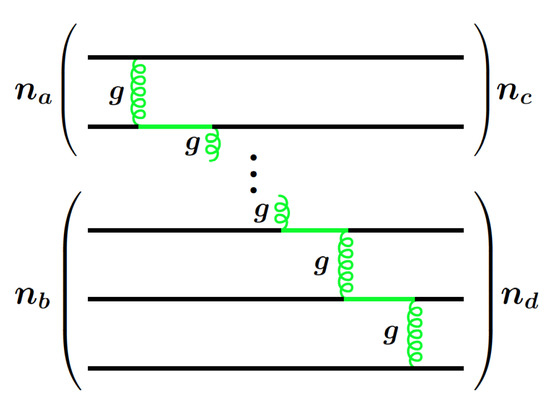
Figure 1.
Hard-gluon exchange process in an exclusive hadron reaction. See text for details.
This constituent-counting rule was confirmed by high-energy exclusive reactions. For example, the cross-section () data are shown for reaction as a function of the center-of-mass energy, , in Figure 2. At low energies, it indicates bumpy resonance structure, and it becomes constant at high energies, as predicted by the constituent counting rule. Therefore, hadrons and nuclei should be described by quark and gluon degrees of freedom in high-energy reactions. However, the transition energy depends on the reaction process, and it is not easily determined. There are two major reasons for this issue. One is that there are too many processes like the one shown in Figure 1, and the other is that the distribution amplitudes are not well understood, except for the pion distribution amplitude.
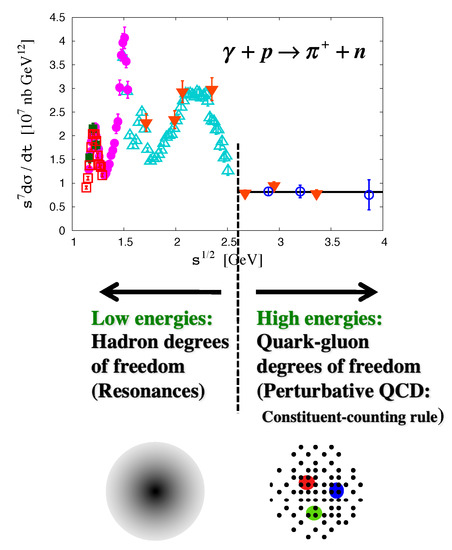
Figure 2.
From hadron degrees-of-freedom (d.o.f.) to quark-gluon d.o.f. and the constituent counting rule in reaction. Top: Cross-section measurements as a function of the center-of-mass energy, : the open red squares show the data by Fischer et al. (1970) [23], the solid black squares show the data by Clifft et al. (1974) [24], the the solid pink circles show the data by Fujii et al. (1977) [25], the open turquoise triangles show the data by CLAS Collaboration (2009) [26], the inverse red triangles show the data by Jeff. Lab. Hall A and E94-104 Collaborations (2005) [27], the open blue circles show the data by Anderson et al. (1976) [28]; see also [29]. Bottom: D.o.f. picture. The grey circle shadowed indicates a proton, the colored circles indicate different quarks, and the dots indicate gluons and sea quarks. “QCD” stays for quantum chromodynamics.
2.2. Color Transparency
Hadron interactions in nuclear medium are valuable for understanding dynamical properties of QCD and for application to high-energy hadron reactions. As seen in the constituent-counting rule in the exclusive hadron reactions, the internal constituents should stick together to form a hadron. Namely, a small hadron component dominates the reaction at a large-momentum transfer. The small-size hadron is expected to pass through the nuclear medium without interactions. This phenomena is called color transparency, and the nuclear transparency, , is used for showing this quantity. Here, and are nuclear and nucleon cross sections, respectively, and A is the mass number of the nucleus. The nuclear transparencies are measured by the reactions and at electron and proton accelerator facilities. The color transparency involves both the energy scale at which a hadron is formed in a point-like configuration, as discussed in Section 2.1, and how it then evolves through the medium. For example, measurements were done at about 90 in the center-of-mass frame in the BNL-AGS experiment [7], so that the large-momentum-transfer mechanism of Section 2.1 could be applied. On the other hand, the expansion of the wave packet is controlled by the proton momentum in the final state as its expansion is characterized by the coherence length which is proportional to the proton momentum [30]. The color transparency contains these two mechanisms. The reaction is illustrated in Figure 3 together with the expectation on the nuclear transparency. At low energies, hadrons interact strongly with nucleons in the nucleus, so that the nuclear transparency is small. As the energy increases, it becomes larger, and T should become one in the high-energy limit according to the color transparency.
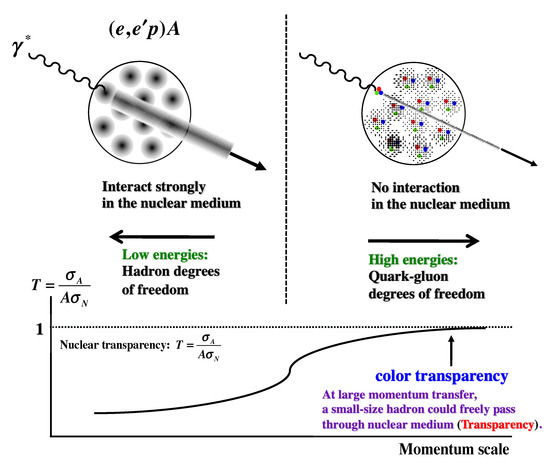
Figure 3.
Color transparency in high-energy electron scattering .
The BNL-AGS data [7] are shown in Figure 4 for the nuclear transparency in the reaction as the function of the beam momentum. As the hard scale of the reaction, the proton-beam energy, in this case, becomes larger, the transparency is expected to increase. In fact, the transparency increases as the momentum becomes larger up to GeV/c; however, it drops at GeV/c. This result seems to be in contradiction to the color transparency expectation, and it is not easily explained theoretically. Since J-PARC has a 30-GeV primary-proton-beam energy, the larger momentum region can be measured and the transparency phenomena shown in Figure 3 and Figure 4 should be tested. Therefore, J-PARC provides a valuable opportunity for investigating basic hadron interactions in the nuclear medium as predicted by perturbative QCD.
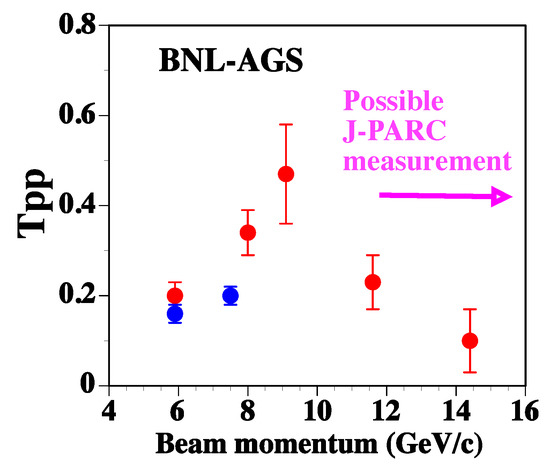
Figure 4.
Nuclear transparency, , in reactions by BNL-AVA experiment [7].
Next, a new reaction process was proposed for investigating the color transparency phenomena by using the high-momentum pion beam at J-PARC and COMPASS/AMBER [30]. In particular, hard branching processes was studied as illustrated in Figure 5. The basic reaction process is shown in Figure 6, where the kinematics of the upper hard-reaction part are controlled by the lower part . These hard branching processes with nuclei provide an effective way to determine the momentum transfers needed for effects of point-like configurations to dominate large-angle processes.
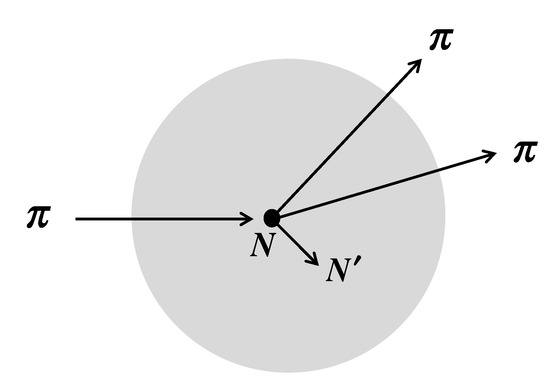
Figure 5.
process for color transparency.
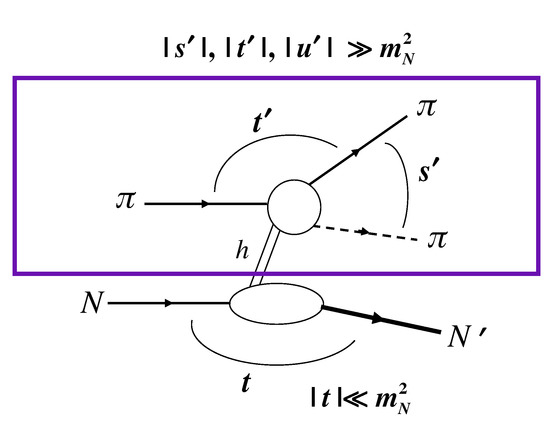
Figure 6.
process. Here, , t, , u, are the Mandelstam variables, denotes the mass of the nucleon, and h indicates the intermediate hadronic state.
Calculated nuclear transparencies are shown in Figure 7 as the functions of the pion-beam energy for three different nuclei [30]. The reaction allows the effects of the transverse size of configurations to be decoupled from effects of the space-time evolution of these configurations, which is different from past methods. Namely, it is a new method for probing the dynamics of large angle hadron-hadron scattering using the color-transparency phenomenon which is free from the limitations imposed by the expansion effects of the point-like configurations. The beam energies are in the 20–200 GeV range, namely from the J-PARC to COMPASS/AMBER energies, and they are appropriate for these reaction studies.
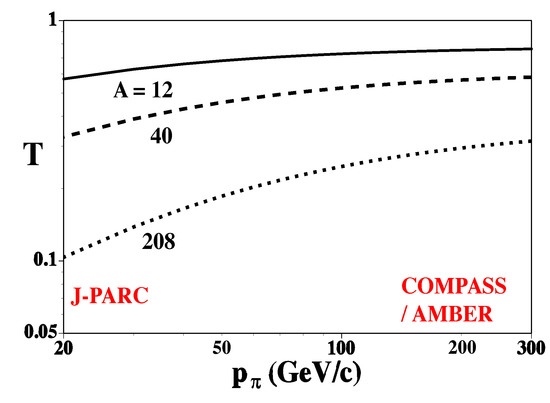
Figure 7.
Color transparency in process . Taken from [30].
3. Possible J-PARC Project on Generalized Parton Distributions
3.1. J-PARC Hadron Facility
The J-PARC provides the most intense proton beam in the energy region above multi-GeV, and it is a multi-purpose facility, with applications ranging from nuclear and particle physics, material and life sciences to industrial applications. Nuclear and particle physics experiments are done by secondary beams (pions, kaons, neutrinos, muons, and antiprotons) as well as the primary 30-GeV proton beam.
Hadron physics projects are done in the hadron experimental hall shown in Figure 8. There are also particle-physics projects on lepton-flavor violation and rare kaon decays in this hadron hall. The K1.8 indicates kaons with momentum around 1.8 GeV/c, and this beamline is used for strangeness nuclear physics such as strangeness −2 hypernuclei with by the reaction. The K1.1 beamline is intended for low-momentum stopped kaon experiments such as the studies of kaonic nuclei. The high-momentum beamline is indicated for 30 GeV protons and unseparated hadrons, which are essentially pions with up to about 20 GeV/c momentum. Using these high-momentum protons and pions, one can investigate interesting high-energy hadron physics topics, particularly in the transition region from hadron to quark-gluon degrees of freedom, as explained in this paper.
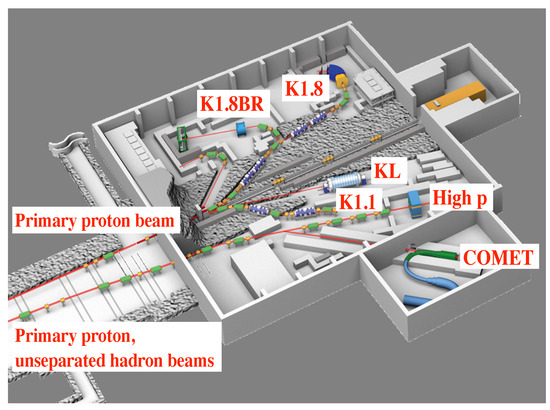
Figure 8.
The Japan Proton Accelerator Research Complex (J-PARC) hadron hall.
3.2. Generalized Parton Distributions
The studies of color transparency are closely related to the GPD measurements in connection with factorization and reaction mechanisms. The spacelike GPDs have been measured in deeply virtual Compton scattering and meson productions at charged-lepton accelerator facilities. On the other hand, the timelike GPDs are measured in two-photon processes of reactions, for example, at the KEK-B facility [17]. Furthermore, a GPD measurement is also considered at the Fermilab neutrino facility [31]. In addition to these projects, it is possible to investigate the GPDs at hadron accelerator facilities such as J-PARC.
The quark GPD is given by the amplitude to extract a quark from a hadron and then to insert it into the hadron at a different spacetime point as shown in Figure 9. The generalized scaling variable x and a skewedness parameter are defined by the lightcone momenta and as and . Here, k is the average momentum of the quarks, and is the four momentum transfer for the hadron or the quark. There is another variable t defined by . The variable x indicates the momentum fraction carried by a quark in the hadron, and the skewedness parameter indicates the momentum-transfer fraction. The GPDs are expressed by these three variables (x, , t). The GPDs of the nucleon, , , , and , are defined by the matrix elements of the nonlocal vector and axial-vector operators as [13,14,15].
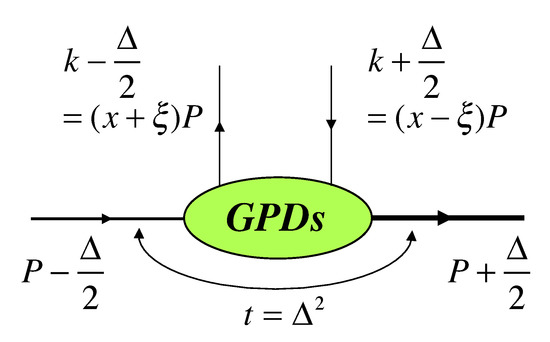
Figure 9.
Generalized parton distribution (GPD) kinematics. See text for details.
These GPDs are very useful quantities. In the forward limit, the GPDs become the unpolarized and longitudinally-polarized PDFs. Their first moments become the corresponding form factors, and their second moment is the quark contribution to the nucleon spin: . Here, is a quark orbital-angular-momentum contribution to the nucleon spin. Because the quark-spin contribution is known from experimental measurements, it is possible to determine from the GPDs. In addition, the GPDs can be used for extracting gravitational form factors of hadrons [17], so that they are also valuable for finding the origin of hadron masses and investigating internal pressure phenomena of hadrons.
3.3. GPDs in the ERBL Region by Process
The reaction processes can be used for probing the GPDs in a unique kinematical region, which is called the ERBL (Efremov–Radyushkin–Brodsky–Lepage) region, shown in Figure 10. The GPDs have three kinematical regions, (I) , (II) , (III) . Region II is called the ERBL region, and the process corresponds to a quark emission of momentum fraction with an antiquark emission of momentum fraction . It is a quark-antiquark (meson) distribution amplitude. Regions I and III are called DGLAP (Dokshitzer–Gribov–Lipatov–Altarelli–Parisi) regions, and the process III (I) corresponds to a quark (antiquark) emission of momentum fraction () with a quark (antiquark) absorption of momentum fraction (). It is a quark (antiquark) distribution amplitude.
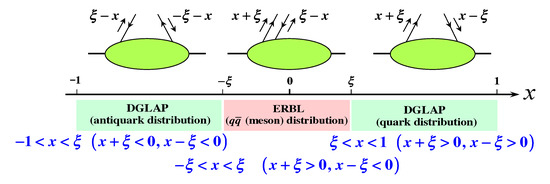
Figure 10.
DGLAP and ERBL regions of GPDs. See text for details.
For investigating the ERBL region, the use of the hadronic process [9] was proposed, where the baryon B could be a nucleon or , in Figure 11. If the pion and the final proton have large and nearly opposite transverse momenta and a large invariant energy, an intermediate exchange could be considered as a state. This attached to the nucleon is expressed by the GPDs in the ERBL region. This experiment is possible at J-PARC, and it is complementary to other GPD measurements because of this uniqueness in the ERBL kinematics. The () cross-sections are shown in Figure 12 for the proton beam energy of 30 and 50 GeV by considering the J-PARC experiment [9]. In the hard kinematical region, with , the cross-section could be factorized into the GPD part and the hadron ()-proton scattering part as , where h indicates the intermediate hadronic state. Here, the transverse sizes of the projectile and two outgoing hadrons near the interaction point are given by , so that the color transparency arguments are essential in proving the factorization for an exclusive hadron production [12]. Actually, this factorization was proved for the deeply virtual meson-production process in Ref. [12], so that such a study is needed for the current hadronic reaction. Depending on the final state or n and the proton-beam energy, the cross section and the kinematical range vary. This is a unique opportunity to investigate the ERBL region of the GPDs.
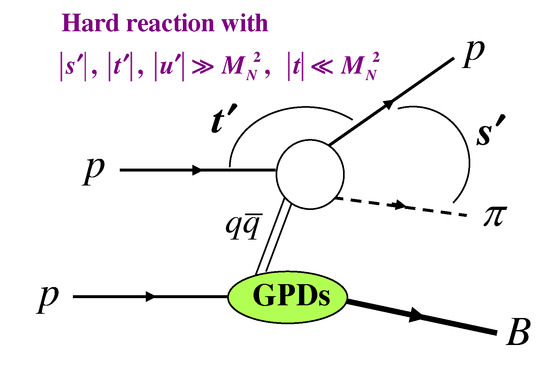
Figure 11.
Typical process and GPD in the ERBL region. See text for details.
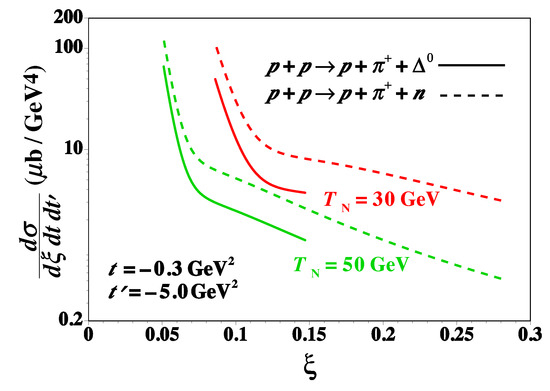
Figure 12.
Cross sections for . Taken from [9].
3.4. GPDs by Exclusive Drell–Yan Process
The GPDs can be investigated by the exclusive Drell–Yan process at J-PARC [10,32], and the experimental proposal is under preparation now [11]. This part is discussed in details by W.-C. Chang [33]. The unseparated hadron beam, which is essentially the pion beam, is available at the high-momentum beamline of J-PARC. The beam momentum is up to about 20 GeV/c. A typical process is shown in Figure 13 with the GPDs. The nucleonic GPDs are investigated if B is the neutron, whereas the transition GPDs are studied for . In addition to the GPDs, the pion distribution amplitude is involved in the reaction; however, it could be taken from other theoretical and experimental studies [34]. Therefore, the GPDs should be extracted from experimental measurements. For such studies, one should note that possibly a large contribution could come from another non-factorized process called the Feynman mechanism, and it needs to be taken into account properly [35,36].
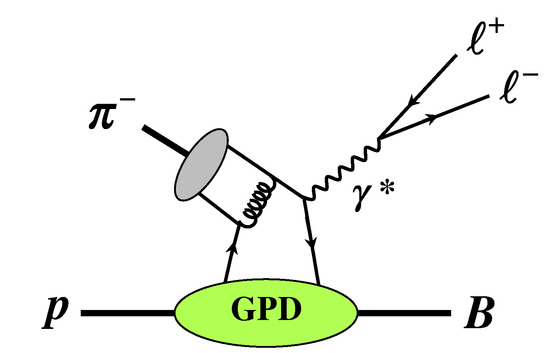
Figure 13.
Exclusive Drell–Yan process.
A new proposal will be submitted soon for this project [11] in collaboration with the approved E50 experiment on charmed baryons [37]. In this experiment, the muon identification system is added to the E50 spectrometer as shown in Figure 14. The details of the detectors are explained in Refs. [10,11]. The exclusive Drell–Yan process can be identified by the missing-mass technique. The actual Monte Carlo simulation is shown in Figure 15 as the function of the missing mass for the pion momentum GeV/c. It is clear that the exclusive Drell–Yan process is identified in comparison with other contributions from the inclusive Drell–Yan, production, and random-background processes. This measurement probes the GPDs in the region by the timelike photon, which is complementary to the JLab meson-production experiment with the spacelike photon. In addition, pion-to-nucleon transition distribution amplitudes can be investigated by backward charmonium production in pion-nucleon collisions [38]. Strangeness-hadron production experiments are possible at J-PARC as mentioned in Ref. [33], so the discussed topics in this paper could be investigated, including strangeness. Furthermore, it is expected that a separated high-momentum kaon beam will become available in the future [39]. The color-transparency and the GPD (Figure 12) experiments are still under consideration at J-PARC. A hope is that these experiments will be realized in addition to the exclusive Drell–Yan experiment.

Figure 14.
Detector design for the J-PARC GPD experiment [10].
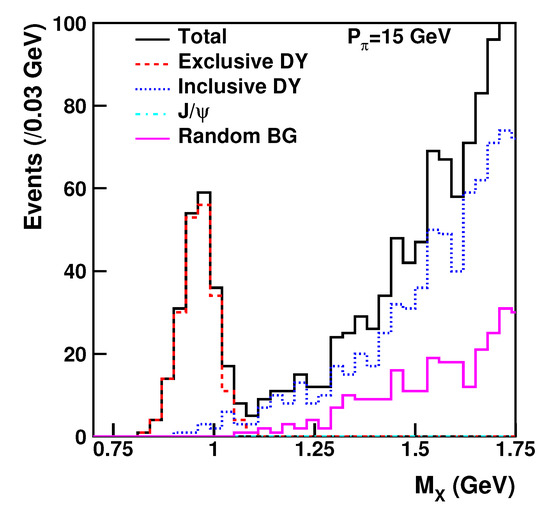
Figure 15.
Monte Carlo simulation for the missing-mass, , spectra of the events at the pion momentum, GeV/c [10].
4. Summary
Japan Proton Accelerator Research Complex (J-PARC) is the most intense proton-accelerator facility above the multi-GeV region. By using high-momentum beams, it is possible to have unique experiments on color transparency and the generalized parton distributions (GPDs). In particular, it should be the key experiment to solve the mysterious BNL-AVA result on the color transparency. In addition, the process ( reaction) provides a unique opportunity to separate the transverse size configurations from space-time evolution in contrast to the past studies. Next, the J-PARC GPD experiment on the exclusive Drell–Yan processes is a complementary project to the JLab project because of the smaller-x kinematical region and the timelike photon instead of the spacelike photon. Another possible GPD project at J-PARC on the reaction is also discussed to investigate the Efremov-Radyushkin-Brodsky-Lepage (ERBL) region of the GPDs. All these projects are valuable for the development of high-energy hadron physics along with the experimental projects at other facilities such as JLab (Jefferson Laboratory), Fermilab, KEKB, NICA, FAIR, LHCspin, EIC, EicC, and others. From these measurements, one can understand basic mechanisms of high-energy hadron reactions in nuclear medium. Furthermore, the GPD studies will lead to clarifications on the origins of hadron spins, masses, and internal pressures.
Funding
S. Kumano was partially supported by Japan Society for the Promotion of Science (JSPS) Grants-in-Aid for Scientific Research (KAKENHI) Grant Number 19K03830.
Data Availability Statement
Not applicable.
Acknowledgments
The author thanks T. Takahashi for suggestions on the J-PARC experiments.
Conflicts of Interest
The author declares no conflict of interest.
References
- J-PARC Web Page. Available online: https://j-parc.jp/researcher/index-e.html (accessed on 8 May 2021).
- Program Advisory Committee for Nuclear and Particle Physics Experiments. Available online: https://j-parc.jp/researcher/Hadron/en/PAC_for_NuclPart_e.html (accessed on 8 May 2021).
- Ichikawa, Y.; Yamagata-Sekihara, J.; Ahn, J.K.; Akazawa, Y.; Aoki, K.; Botta, E.; Ekawa, H.; Evtoukhovitch, P.; Feliciello, A.; Fujita, M.; et al. An event excess observed in the deeply bound region of the 12C(K-,p) missing-mass spectrum. Prog. Theor. Exp. Phys. 2020, 2020, 123D01. [Google Scholar] [CrossRef]
- Yamaga, T.; Ajimura, S.; Asano, H.; Beer, G.; Bhang, H.; Bragadireanu, M.; Buehler, P.; Busso, L.; Cargnelli, M.; Choi, S.; et al. [J-PARC E15 Collaboration]. Observation of a K¯NN bound state 3He(K-,p)n reaction. Phys. Rev. C 2020, 102, 044002. [Google Scholar] [CrossRef]
- Hayakawa, S.H.; Agari, K.; Ahn, J.K.; Akaishi, T.; Akazawa, Y.; Ashikaga, S.; Bassalleck, B.; Bleser, S.; Ekawa, H.; Endo, Y.; et al. Observation of Coulomb-assisted nuclear bound state of Ξ--14N system. Phys. Rev. Lett. 2021, 126, 062501. [Google Scholar] [CrossRef] [PubMed]
- Yoshimoto, Y.; Ahn, J.K.; Bassalleck, B.; Ekawa, H.; Endo, Y.; Fujita, M.; Han, Y.; Hashimoto, T.; Hayakawa, S.H.; Hicks, K.; et al. First observation of a nuclear s-state of a Ξ hypernucleus, . Prog. Theor. Exp. Phys. 2021, 2021, 073D02. [Google Scholar] [CrossRef]
- Aclander, J.; Alster, J.; Asryan, G.; Averiche, Y.; Barton, D.S.; Baturin, V.; Buktoyarova, N.; Bunce, G.; Carroll, A.S.; Christensen, N.; et al. Nuclear transparency in quasielastic A(p,2p) reactions. Phys. Rev. C 2004, 70, 015208. [Google Scholar] [CrossRef] [Green Version]
- Bhetuwal, D.; Matter, J.; Szumila-Vance, H.; Kabir, M.L.; Dutta, D.; Ent, R.; Abrams, D.; Ahmed, Z.; Aljawrneh, B.; Alsalmi, S.; et al. Ruling out color transparrency in quasielastic 12C(e,e′p) up to Q2 of 14.2 (GeV/c)2. Phys. Rev. Lett. 2021, 126, 082301. [Google Scholar] [CrossRef]
- Kumano, S.; Strikman, M.; Sudoh, K. Novel two-to-three hard hadronic processes and possible studies of generalized parton distributions at hadron facilities. Phys. Rev. D 2009, 80, 074003. [Google Scholar] [CrossRef]
- Sawada, T.; Chang, W.-C.; Kumano, S.; Peng, J.-C.; Sawada, S.; Tanaka, K. Accessing proton generalized parton distributions and pion distribution amplitudes with the exclusive pion-induced Drell-Yan process at J-PARC. Phys. Rev. D 2016, 93, 114034. [Google Scholar] [CrossRef] [Green Version]
- Ahn, J.K.; Ashikag, S.; Chang, W.-C.; Choi, S.; Diehl, S.; Goto, Y.; Hicks, K.; Igarashi, Y.; Joo, K.; Kumano, S.; et al. Letter of Intent: Studying Generalized Parton Distributions with Exclusive Drell-Yan Process at J-PARC; J-PARC: Tokai, Japan, 2018; Available online: https://j-parc.jp/researcher/Hadron/en/pac_1901/pdf/LoI_2019-07.pdf (accessed on 8 May 2021).
- Collins, J.C.; Frankfurt, L.; Strikman, M. Proof of factorization for exclusive deep-inelastic processes. In Low x Physics, Proceedings of the Madrid Workshop, Madrid, Spain, 18–21 June 1997; Barreiro, F., Labarga, L., del Peso, J., Eds.; World Scientific: Singapore, 1998; pp. 296–303. [Google Scholar]
- Diehl, M. Generalized parton distributions. Phys. Rep. 2003, 388, 41–277. [Google Scholar] [CrossRef] [Green Version]
- Ji, X. Generalized parton distributions. Annu. Rev. Nucl. Part. Sci. 2004, 54, 413–450. [Google Scholar] [CrossRef] [Green Version]
- Moutarde, H.; Sznajder, P.; Wagner, J. Border and skewness functions from a leading order fit to DVCS data. Eur. Phys. J. C 2018, 78, 890. [Google Scholar] [CrossRef] [Green Version]
- PARTONS Project. Available online: http://partons.cea.fr/partons/doc/html/index.html (accessed on 8 May 2021).
- Kumano, S.; Song, Q.-T.; Teryaev, O.V. Hadron tomography by generalized distribution amplitudes in the pion-pair production process γ*γ→π0π0 and gravitational form factors for pion. Phys. Rev. D 2018, 97, 014020. [Google Scholar] [CrossRef] [Green Version]
- Kawamura, H.; Kumano, S. Tomography of exotic hadrons in high-energy exclusive processes. Phys. Rev. D 2014, 89, 054007. [Google Scholar] [CrossRef] [Green Version]
- Kawamura, H.; Kumano, S.; Sekihara, T. Determination of exotic hadron structure by constituent-counting rule for hard exclusive processes. Phys. Rev. D 2013, 88, 034010. [Google Scholar] [CrossRef] [Green Version]
- Chang, W.-C.; Kumano, S.; Sekihara, T. Constituent-counting rule in photoproduction of hyperon resonances. Phys. Rev. D 2016, 93, 034006. [Google Scholar] [CrossRef] [Green Version]
- Schumacher, R.A.; Sargsian, M.M. Scaling and resonances in elementary K+Λ photoproduction. Phys. Rev. C 2011, 83, 025207. [Google Scholar] [CrossRef] [Green Version]
- Amaryan, M.J.; Briscoe, W.J.; Ryskin, M.G.; Strakovsky, I.I. Experimental tests of QCD scaling laws at large momentum transfer in exclusive light-meson photoproduction. Phys. Rev. C 2021, 103, 055203. [Google Scholar] [CrossRef]
- Fischer, G.; Fischer, H.; Heuel, M.; von Holtey, G.; Knop, G.; Stumpfig, J. Photoproduction of positive pions on hydrogen at photon energies between 220 and 425 MeV. Nucl. Phys. B 1970, 16, 119–124. [Google Scholar]
- Clifft, R.W.; Gabathuler, E.; Littenberg, L.S.; Marshall, R.; Rock, S.E.; Thompson, J.C.; Ward, D.L.; Brookes, G.R. Search for ΔI = 2 electromagnetic currents in pion photoproduction. Phys. Rev. Lett. 1974, 33, 1500–1503. [Google Scholar] [CrossRef]
- Fujii, T.; Kondo, T.; Takasaki, F.; Yamada, S.; Homma, S.; Huke, K.; Kato, S.; Okuno, H.; Endo, I.; Fujii, H. Photoproduction of charged π mesons from protons and neutrons in the energy range between 250 and 790 MeV. Nuc. Phys. B 1977, 120, 395–422. [Google Scholar] [CrossRef]
- Dugger, M.; Ritchie, B.G.; Ball, J.P.; Collins, P.; Pasyuk, E.; Arndt, R.A.; Briscoe, W.J.; Strakovsky, I.I.; Workman, R.L.; Amaryan, M.J.; et al. [CLAS Collaboration]. π+ photoproduction on the proton for photon energies from 0.725 to 2.875 GeV. Phys. Rev. C 2009, 79, 065206. [Google Scholar] [CrossRef] [Green Version]
- Zhu, L.Y.; Arrington, J.; Averett, T.; Beise, E.; Calarco, J.; Chang, T.; Chen, J.P.; Chudakov, E.; Coman, M.; Clasie, B.; et al. [Jefferson Lab Hall A Collaboration and Jefferson Lab E94-104 Collaboration]. Cross section measurements of charged pion photoproduction in hydrogen and deuterium from 1.1 to 5.5 GeV. Phys. Rev. C 2005, 71, 044603. [Google Scholar] [CrossRef] [Green Version]
- Anderson, R.L.; Gustavson, D.B.; Ritson, D.M.; Weitsch, G.A.; Halpern, H.J.; Prepost, R.; Tompkins, D.H.; Wiser, D.E. Measurements of exclusive photoproduction processes at large values of t and u from 4 to 7.5 GeV. Phys. Rev. D 1976, 14, 679–697. [Google Scholar] [CrossRef] [Green Version]
- Zhu, L.Y.; Arrington, J.; Averett, T.; Beise, E.; Calarco, J.; Chang, T.; Chen, J.P.; Chudakov, E.; Coman, M.; Clasie, B.; et al. [Jefferson Lab Hall A Collaboration]. Cross-section measurement of charged-pion photoproduction from hydrogen and deuterium. Phys. Rev. Lett. 2003, 91, 022003. [Google Scholar] [CrossRef] [PubMed] [Green Version]
- Kumano, S.; Strikman, M. Using branching processes in nuclei to reveal dynamics of large-angle, two-body scattering. Phys. Lett. B 2010, 683, 259–263. [Google Scholar] [CrossRef] [Green Version]
- Kumano, S.; Petti, R. Possible studies on generalized parton distributions and gravitational form factors in neutrino reactions. PoS 2022, NuFact2021, 092. [Google Scholar] [CrossRef]
- Berger, E.R.; Diehl, M.; Pire, B. Probing generalized parton distributions in πN→ℓ+ℓ-N. Phys. Lett. B 2001, 523, 265–272. [Google Scholar] [CrossRef] [Green Version]
- Chang, W.-C. Measuring Pion-Induced Exclusive Drell-Yan Process at J-PARC. Talk at the Online Workshop The Future of Color Transparency and Hadronization Studies at Jefferson Lab and Beyond, 7–8 June 2021. Available online: https://indico.jlab.org/event/437/contributions/8370/attachments/7020/9676/CT2021_ExclusiveDY_wchang.pdf (accessed on 3 May 2022).
- Roberts, C.D.; Richards, D.G.; Horn, T.; Chang, L. Insights into the emergence of mass from studies of pion and kaon structure. Prog. Part. Nucl. Phys. 2021, 120, 103883. [Google Scholar] [CrossRef]
- Tanaka, K. QCD mechanisms for accessing the nucleon GPDs with the exclusive pion-induced Drell-Yan process at J-PARC. arXiv 2017, arXiv:1703.02190. [Google Scholar] [CrossRef]
- Tanaka, K. Exclusive pion-induced Drell-Yan process at J-PARC for accessing the nucleon GPDs and soft nonfactorizable mechanism. PoS 2017, DIS2017, 249. [Google Scholar] [CrossRef] [Green Version]
- Morino, Y.; Nakano, T.; Noumi, H.; Shirotori, K.; Sugaya, Y.; Yamaga, T.; Ozawa, K.; Ishikawa, T.; Miyachi, Y.; Tanida, K. P50 Proposal: Charmed Baryon Spectroscopy via the (π,D*-) Reaction; KEK/J-PARC-PAC 2012-19 Report; KEK: Tsukuba, Japan, 2012; Available online: http://www.j-parc.jp/researcher/Hadron/en/Proposal_e.html (accessed on 8 May 2021).
- Pire, B.; Semenov-Tian-Shansky, K.; Szymanowski, L. Backward charmonium production in πN collisions. Phys. Rev. D 2017, 95, 034021. [Google Scholar] [CrossRef] [Green Version]
- J-PARC Workshop on Review of Hadron Experimental-Facility Extension, 10–25 August 2021, Tokai, Japan. Available online: https://kds.kek.jp/event/38930/ (accessed on 8 May 2021).
Publisher’s Note: MDPI stays neutral with regard to jurisdictional claims in published maps and institutional affiliations. |
© 2022 by the author. Licensee MDPI, Basel, Switzerland. This article is an open access article distributed under the terms and conditions of the Creative Commons Attribution (CC BY) license (https://creativecommons.org/licenses/by/4.0/).